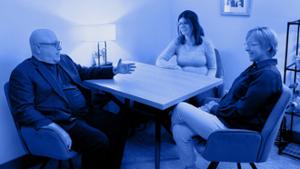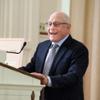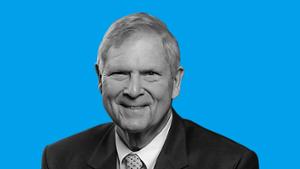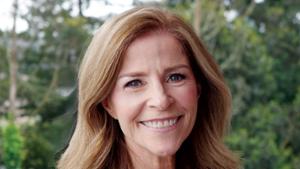A Moment that Changed Hundreds of Lives: A Chat with Vinnie Strully ’69

This summer marks the 50th anniversary of The New England Center for Children (NECC), the life’s work of its founder and longtime CEO, Vinnie Strully ’69. Looking back, how did a Hamilton government major, with no clear career path, go on to establish what would become one of the world’s leading organizations for the treatment of children and adolescents with autism just five years after graduating?
Strully credits a turning point that came on the morning of his 25th birthday. We asked him to share the story — and he did (edited for length).
Feature photo above: Vinnie Strully (left) meets with fellow NECC staffers Jackie Rogalski ’10 (center) and Kim Wysocki Keogh ’90.

After graduation, I did a year of graduate studies in political science at Syracuse, thanks to my senior advisor, Professor Eugene Lewis, who had completed his Ph.D. there. But I quickly realized it wasn’t for me. I wanted to do something that involved direct service, so I found a job as a residential childcare worker at Vanderheyden Hall in Troy, N.Y.
I worked around the clock, living alongside a group of kids. I started to get pretty good at it, but I struggled with some of the more complex behavioral challenges. It became clear I needed to find a place with deeper expertise — somewhere that truly understood how to teach important skills to these kids.
It became clear I needed to find a place with deeper expertise — somewhere that truly understood how to teach important skills to these kids.
But first I took a break to travel. It was October 1971, and I was in Europe, spending time in Florence with a Hamilton friend, Harry Weintraub [’68]. I had saved money from the childcare job and was making plans with other Hamilton friends to travel to Afghanistan or North Africa.
But then, on the morning of my 25th birthday, I woke up with a jolt. My first thought was, “This is your 25th birthday. If you were 30 today, you’d be completely lost.” That moment hit hard.
I shaved off my Jerry Garcia-style beard, cut my shoulder-length hair, and headed home. Within three weeks, I landed a job at Spaulding Youth Center in Tilton, N.H. There, a young executive director named John Pangburn was launching one of the first programs for children based on applied behavior analysis — then referred to as behavior modification. The approach offered a structured, systematic way to teach children with special needs.
About a year-and-a-half in at Spaulding, John approached me with the idea of creating a program specifically for children with autism. At the time, neither of us knew much about it. We split up the available literature and dove into an intense two-year journey of learning everything we could.
Eventually, John suggested relocating to Massachusetts, where the state was preparing to launch schools for children with the condition. We developed a proposal and secured a grant to open a program in Taunton on the grounds of a state hospital. The Department of Mental Health offered us a former nurse’s residence, which we began renovating to serve a group of 10 to 20 students.
In 1974, we moved. It took 10 months of hard work to get things off the ground. Although our mission was compelling, autism was still largely misunderstood. We didn’t know that we were standing at the forefront of something much bigger. Over the next 50 years, autism would become one of most commonly diagnosed developmental disorders. That realization and that journey was the beginning of what would become the New England Center for Children.
[John moved on in 1978, leaving Strully at a crossroads. Though he initially considered pursuing special education at Columbia, he decided instead to continue the work they had started and take on the program’s leadership.]
About the New England Center for Children
Established in 1975 and located in Southborough, Mass., the New England Center for Children (NECC) is a leading nonprofit dedicated to providing comprehensive, evidence-based educational services for children with autism spectrum disorder. The center provides both day and residential programs that combine individualized instruction with evidence-based applied behavior analytic treatment. The NECC extends its reach through partner classrooms in public schools across New England and operates international programs in the United Arab Emirates and Qatar.
NECC’s Autism Curriculum Encyclopedia software is used by more than 13,000 learners worldwide. Additionally, the center fosters professional development by partnering with higher education institutions — including Hamilton — to offer free on-site graduate programs and internship opportunities in special education and behavior analysis.
My vision was to create the educational equivalent of a teaching hospital — an environment where children with autism could receive high-quality education alongside active university partnerships, on-site research, and professional development. I imagined a place where people from around the world could come for both treatment and training in autism education.
To move this vision forward, I began reaching out to leading behavior analysts in the area. One of them completed his Ph.D. under B.F. Skinner [Hamilton, Class of 1926] at Harvard and joined us, staying through the mid-1980s. By that time, I had built my own team and was beginning to take strategic risks.
One of the lasting benefits of a Hamilton education was learning how to approach complex challenges — to figure things out, tackle tough subjects, and work through them with persistence.
Although I’d only been working with children for about 10 years, I came from a medical family, so I understood the importance of research. I also recognized early on that we’d need strong financial and legal foundations. In the mid-1980s, we secured a $23 million tax-exempt bond at a time when there was a pressing need for more services for children with autism, particularly those with severe needs. We were uniquely positioned — we had a proven model, and by then, I had developed the necessary political and financial relationships to make it happen.
One of the lasting benefits of a Hamilton education was learning how to approach complex challenges — to figure things out, tackle tough subjects, and work through them with persistence.
I’ve been incredibly fortunate. I had two well-educated, generous parents who gave me access to resources and opportunities. I was, by most accounts, quite privileged growing up. It’s surprising I developed a strong work ethic — but I credit that to my father. While I may not have had to work hard early on, I can honestly say I’ve worked hard almost every day for the last 50 years.
Hamilton & The New England Center for Children
Since 1999-2000, Hamilton students have spent the semester
or summer at the New England Center for Children. Here are the numbers:
54
Hamilton students completed summer internships.80
Hamilton students completed the cooperative learning program (master’s level coursework; working with children).15
Hamilton alumni currently work at NECC.Could you share a breakthrough in autism treatment that the NECC has made?
The center has contributed significantly to autism research, including recent work focused on infants from high-risk families with a history of autism or related developmental disabilities. One of our most exciting advancements is the creation of the Early Markers of Autism assessment tool, developed by our research team. Designed to identify early signs of autism in children from birth to 18 months, this tool holds promise for earlier detection and intervention. Once validated, it could be made available to pediatricians, offering a major step forward in early autism diagnosis and treatment. It has the potential to be a true game changer.
NECC has also been recognized with two awards from the Association for Behavior Analysis International — in 2005, for our enduring contributions to the field, and in 2017, for international dissemination of behavior analysis, particularly for our successful replication of NECC’s model in Abu Dhabi.
In addition, our proprietary software, the Autism Curriculum Encyclopedia is used daily by educators worldwide and includes over 2,500 lesson plans grounded in a socially validated assessment framework. This powerful tool supports more than 13,000 students each day, ensuring consistent, high-quality instruction across a variety of educational settings.
Why did you expand to Abu Dhabi?
I’ve been traveling to Abu Dhabi since 1997, when we first connected with a member of a prominent family seeking support for their child. Our success in working with that family opened the door to a wide range of opportunities and partnerships across the region, ultimately allowing us to build a lasting presence.
Are any other programs comparable to the NECC?
Few can match the ecosystem that the New England Center for Children has built. From the beginning, there was a deliberate focus on developing a robust research program — a process that took nearly two decades to fully realize.
We’ve maintained a longstanding partnership with Hamilton, and for nearly 40 years, we've hosted an on-site master’s degree program in special education with an autism specialization through Simmons University. We also partnered with Northeastern University to offer a master’s in behavior analysis, and now, through Western New England University, we provide both master’s and Ph.D. programs in applied behavior analysis.
Over time, we've continually strengthened the quality of our teaching and training. Our research is now featured in peer-reviewed journals, underscoring the real-world effectiveness of our integrated model.
You retired as CEO in 2023 but are still executive advisor, spending winters in Abu Dhabi and the rest of the year in Boston. What’s your plan moving forward?
Walking away was never something I considered. This work — this center — is my legacy and my life’s purpose. Without it, I’m not sure how I would define myself. I’ve spent 50 years doing something I truly loved, alongside an extraordinary group of people, many of whom stayed with NECC for decades. Together, we built exceptional teams of professionals rooted in mutual respect, deep connection, and shared purpose. We accomplished meaningful work and had a great deal of fun along the way, even when the challenges were immense.
Looking back, it all traces back to that morning of my 25th birthday. That moment put me on the right path for the next 50 years of my life.
“Each year, [Professor of Psychology] Jon Vaughan would bring one of his classes to the center to show them how this work applied. He and Professor Doug Weldon, helped to set up the long-standing partnership with NECC and Hamilton. Once my friend Professor Blackwood came with him. After touring the school, he said to me, “Okay, you don’t have to go back to graduate school.”
More from Hamilton magazine

Addressing Global Food Security: Tom Vilsack ’72
Fresh off his second term in the White House as U.S. secretary of agriculture, Tom Vilsack ’72 has joined the World Food Prize Foundation as CEO. The organization is devoted to driving transformative change in food security and sustainable agriculture.

Keeping Kids in the Know: Tori Campbell Nelson ’86
When Tori Campbell Nelson ’86 talks, children listen. The co-founder and anchor of KidNuz, “a fun, fresh, first-of-its-kind kids’ podcast,” delivers age-appropriate news stories to her third- to sixth-grade audience five days a week.

